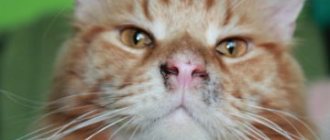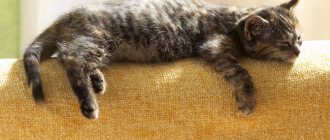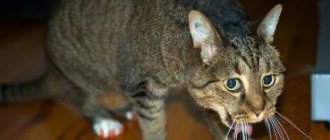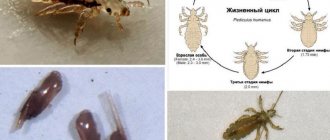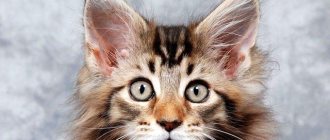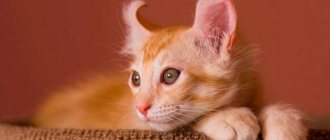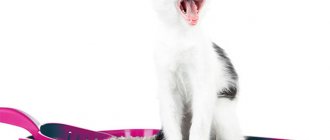Laxatives are medications used to treat constipation. In cats, constipation is manifested by the absence of bowel movements for 2-3 days. Scanty dry feces are also classified as this condition. If the discharge is mucous or bloody, this is a reason to immediately contact a veterinarian. If there is no suspicion that the lack of feces in the animal is caused by an acute pathology and emergency condition, then you can try to cope with constipation yourself at home using laxatives for cats.
About the causes of constipation
Prolonged absence of bowel movements is an alarming symptom; the condition can be accompanied by severe pain. Feces accumulated in the gastrointestinal tract can, over time, cause inflammatory processes, intoxication of the body, and in severe cases lead to complete intestinal obstruction. In the latter case, death is possible.
Delayed defecation has a clear gradation in medicine; it is divided into:
- According to the organic mechanism of action.
Feces are retained in the intestines due to physical obstacles in the form of tumors, neoplasms, and scars.
- According to the functional mechanism of action.
The cat stops going to the toilet due to insufficient activity of the gastrointestinal tract. Reasons: sedentary lifestyle, inappropriate food, inflammation, intoxication, metabolic disorders, chronic diseases.
Also, a distinction is made between partial stool retention (feces are excreted in a minimal amount, the bulk is retained in the body), and complete stool retention (feces remain completely in the intestines).
Additional symptoms to watch out for:
- Painful bowel movements – the animal screams during bowel movements and experiences pain when palpating the abdomen. Possible causes: gastroenteritis, diseases of internal organs, mechanical damage to the pelvis.
- intense bowel movements - a small predator often visits the toilet, feces come out in small portions or there is no bowel movement at all. Constipation gives way to diarrhea, stool has a liquid consistency. Possible causes: gastroenterocolitis, enterocolitis.
Problems with bowel movements often occur as an additional symptom to chronic diseases.
- Inflammatory processes in the gastrointestinal tract develop due to irregular nutrition, too cold or hot food, monotonous diet, poisoning, allergic reactions, parasites, infections. The disease is accompanied by constipation, vomiting, loss of appetite, and aggressive behavior of the animal.
- Inflammation of the pancreas (pancreatitis) develops both as an independent disease and in the case of parasitic infection. Signs: lack of bowel movements, loss of appetite, pain, bloating in the abdominal area.
- Increased gas formation is observed in animals due to improper feeding. Flatulence is accompanied by constipation, the stomach swells and becomes hard, the pet experiences pain and screams.
- Gastrointestinal blockage develops due to hairballs trapped in the stomach; bones for food; sedentary lifestyle; foreign objects swallowed by the cat. Signs: feces are not excreted, colic occurs, the pet’s behavior changes, pain and vomiting occur after eating, the stomach is bloated.
- Excess weight (obesity) occurs due to an unbalanced diet, problems with the liver, and endocrine system. The process of defecation occurs rarely, the pet leads a sedentary lifestyle.
- Lack of weight (dystrophy) develops due to a lack of nutrients in feed. The small predator has virtually no defecation, the animal is extremely thin, the fur is dull, and the mucous membranes are bluish in color.
- Helminth infestation. When infected with helminths, a pet loses weight, refuses food or eats excessively, constipation gives way to diarrhea, behavior changes, the stomach increases in size, and itchy sensations appear in the anus.
Be sure to read:
A cat poops blood: causes, treatment methods, what to do before seeing a doctor, when to sound the alarm
Treatment of constipation with various drugs is directly related to the causes of the unpleasant condition.
Symptoms of the problem
If your pet begins to visit the litter box less often than usual, watch him. For behavioral reasons associated with stale filler, it will regularly make piles in the wrong place. Don't scold your pet for this and change the tray more often. Clean animals rarely walk past their toilet. When an unpleasant odor appears, they can meow loudly, calling on the owner to solve the problem. Be attentive to such situations.
A serious pathology can be indicated when accompanying symptoms appear, including:
- painful and swollen abdomen;
- vomit;
- temperature increase;
- depression and refusal to eat;
- prolonged stay in the tray, accompanied by plaintive meowing;
- mucus or blood in the stool, changes in its color and consistency;
- the presence of blood on the anus or its swelling caused by trauma to the rectum.
The absence of bowel movements, followed by periodic diarrhea, is a sign of enterocolitis, that is, simultaneous inflammation in the small intestine and rectum. Only a doctor can make an accurate diagnosis. After detecting the listed symptoms, be sure to make an appointment with a veterinary clinic.
How often should a cat go to the toilet?
Defecation rate for cats:
- Adult pet – 1 time per day.
- Kitten - 1-2 times a day, kittens have an increased metabolism, food is digested faster.
- Elderly animal - 1 time in two days; in pets older than 6 years, the metabolism decreases.
According to veterinarians, constipation is considered to be a delay of three or more days. Associated symptoms: anxiety, lack of appetite.
Doctors recommend examining your pet's stool to identify the disease at an early stage. In a healthy cat, feces are oblong in shape, dark brown in color, and soft in consistency.
Deviations:
- overly dry, cracked “balls”,
- liquid consistency,
- unusual color (gray, yellow, red),
- presence of foreign inclusions
First aid for constipation
You can quickly help your cat at home by giving the animal an enema or inserting a rectal suppository into the anus.
Rectal laxatives with glycerin for humans can also be used for cats. Half a candle is placed on the cat. Cut the candle lengthwise, carefully insert it into the anus, hold the pet in your arms, stroking the belly in a circular motion to stimulate peristalsis. Repeat the procedure after 4-5 hours; if there is no bowel movement, administer an enema.
Treatment at home
In the initial stage, you can get rid of the problem at home.
- Changing your diet.
You need to start feeding the cat fractionally liquid food (5-6 times a day), the portions should be small, you should add a little vegetable oil and bran to the food.
- Feeding with vegetables.
You need to add raw carrots and beets, chopped in a blender, to your daily food. If the cat does not want to eat vegetables, you should squeeze out the vegetable juice through gauze and inject it into the mouth through a syringe without a needle.
- Introduction to the diet of foods that normalize digestion.
Be sure to read:
A cat often burps: causes, symptoms, what to do when vomiting after eating, prevention, what not to do
Fermented milk products with low fat content (kefir, fermented baked milk, yogurt) can normalize the animal’s digestive processes.
- Daily massage.
You can massage your cat's belly daily, stroking it clockwise with force.
Preventive measures
Prevention of constipation in cats consists of fulfilling the following conditions:
- provide the cat with free access to a sufficient amount of drinking water when feeding it dry food;
- introduce ballast substances (fiber) into the diet;
- do not use rough food when feeding your cat (bones, large amounts of cartilage);
- deworm the animal regularly - if a cat has constipation due to a helminthic infestation, you first need to deal with the constipation, otherwise the intoxication will worsen due to the presence of dead and decaying helminths in the intestines against the background of constipation;
- Brush your cat regularly to prevent ingestion of fur during shedding;
- use Malt paste - a product that helps remove ingested hair;
Malt paste facilitates the removal of ingested hair from the cat’s body, thereby preventing constipation
- promote physical activity of the cat, play with it;
- use probiotics, especially after antibacterial therapy (Bifitrilak 0.1 - once a day, course 10 days);
- Take your pet to the veterinarian for identification, treatment, and prevention of diseases, the symptom of which is constipation.
Laxatives: Top 5
- Medicines based on lactulose (“Dufolak”, “Romphalak”, “Gudalak”). The drugs can be used for a long time, the drugs are suitable for animals, have a gentle effect on intestinal motility, and are safe for health. Bowel movement occurs within 2-3 hours, taken in the morning and evening, single dose – 0.5 mg per kilogram of weight.
- Magnesium sulfate solution. The product acts on receptors in the walls of the gastrointestinal tract, effectiveness is achieved after 7-10 hours. single dose – 2-4 mg.
- “Ramnil” is a medicine made from buckthorn bark. The drug in tablet form is given to the animal once a day. A single dose is half a tablet.
- Carlsbad salt solution. The product helps improve digestion processes and leads to gentle bowel movements. Dilute a tablespoon of powder in 100 ml of water and give to the cat 2 times a day.
- “Izafenin”. Taking the powder helps cope with chronic constipation and is used as prescribed by a veterinarian.
Medicines
Most laxatives for humans are contraindicated in cats, with the exception of certain medications. Thus, Guttalax, Slabilen, Senade, Magnesium sulfate, which are widely used for constipation, give the effect too quickly for cats that they do not have time to reach the litter box. In addition, these medications cause severe pain and cramping. And they can only be prescribed by a veterinarian after examination.
Based on the type of action and composition, laxatives are divided into several groups:
| Varieties | Peculiarities | Exposure time | Drugs |
| Bulk-forming laxatives | Not digested in the gastrointestinal tract. They increase in volume when interacting with liquid. Feces become softer and increase in volume. | 12-72 hours after administration | Vetelakt |
| Osmotic laxatives | They draw fluid into the intestines, due to which the stool increases in volume and provokes the urge and defecation. The main component is lactulose. | In 24-48 hours | Duphalac, Lactusan, Prelax |
| Stimulant laxatives | Irritate the walls of the large intestine, thereby increasing its activity | 6-10 hours after administration | Bisacodyl |
| Oily laxatives or lubricants | They lubricate feces and coat the intestinal walls, which prevents water loss and facilitates the passage of feces through the intestines. | 3-6 hours | Vaseline oil, Bimin (base – Vaseline oil) |
Nutritional supplements
Food supplements are produced based on cereals (wheat), bran, cereals, plantain seeds (psyllium), and pumpkin as sources of dietary fiber. The purpose of their use is to increase the volume of intestinal contents and thereby stimulate its activity.
Fiber-based laxatives for cats are bulk-forming. They pass through the digestive tract undigested. Once in the large intestine, they take up water and increase in volume. The feces become larger and softer, their contact with the colon increases, and this helps the cat to defecate. At the same time, fibers also take away toxins: ammonia and bile acids.
Oat bran, beet press, vegetables are also healthy fiber. But it ferments well, so it is not suitable as a mild laxative for cats. Such fibers do not increase the volume of feces and do not remove toxins.
Many manufacturers have lines of foods for cats with digestive disorders that contain fiber. Bran is also added to food. You can give 1-2 tbsp per serving. spoons of bran or 1-4 teaspoons of psyllium. In this case, the cat needs to be given plenty of water.
Additional functional nutrition in the form of a paste is also available for sale. Phytojelly for cats Senior and Junior with chicken flavor is produced under the Fitoelita brand. It supplements nutrition with nutrients, improves digestion, stabilizes appetite, and fights constipation and flatulence. Phytojelly is given 1-3 times a week with food or separately, squeezing 1-3 cm from the tube onto the cat’s paw so that he licks it off.
Enema
The procedure is carried out as follows:
- Prepare an enema solution. Dissolve a pinch of salt in warm water. Take an enema.
- Lubricate the animal's anus and the enema tip with Vaseline oil.
- Slowly insert the tip into the anus (in a circular motion).
- Pour in the solution.
- Remove the enema, press the pet's tail to the anus, hold it in your arms for 10-15 minutes.
Be sure to read:
Cat peeing with blood: causes, first aid, how to treat it at home, consequences
Vaseline oil for constipation
Vaseline oil is a safe remedy that is given to a cat when there are problems with the intestines. The product can be injected through a syringe into the anus; another option is to inject it into the mouth through a syringe without a needle.
The oil can soften feces. move feces through the intestines. The pet's intestines are emptied 3-5 hours after the administration of the oil. single dose – 3-5 ml.
The danger of going without bowel movements for a long time
With prolonged absence of stool, feces accumulate in the intestines. If the delay is partial, then the accumulation process lasts longer, but this does not reduce its danger.
Feces are toxic waste. The longer they remain in the body, the more they poison it. This affects the functioning of internal organs and can provoke the appearance of tumors. When a complete blockage occurs, intestinal obstruction occurs - a dangerous condition that can be fatal.
Under the pressure of feces, the intestinal walls can rupture. All contents will enter the body, causing severe intoxication. To avoid the death of your pet, you should urgently contact a veterinary clinic if the cat has not walked for more than 2-3 days in a row.

